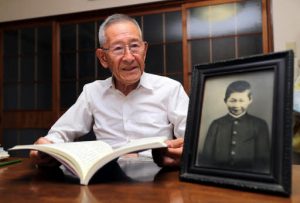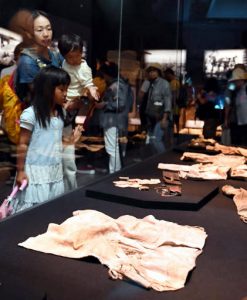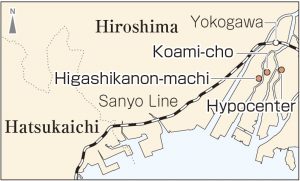Brother’s blood-stained shirt at Peace Memorial Museum conveys A-bomb’s catastrophic results
Aug. 7, 2019
by Junji Akechi, Staff Writer
Akira Sakanoue was 12 years old and a first-year student at Hiroshima Municipal Middle School (now Motomachi High School) when he lost his life in the atomic bombing. The shirt he was wearing at the time has a burnt sleeve and blood stains, conveying the tragic consequences of that fateful day 74 years ago. The shirt is now on permanent display in the main building of the Hiroshima Peace Memorial Museum, which reopened in April are undergoing extensive renovations. Akira’s brother, Takashi Sakanoue, 89, a resident of Nishi Ward, said, “His shirt will continue to convey the catastrophic results of the atomic bombing to future generations.” Takashi is now in poor health.
On August 6, 1945, Takashi was in Hatsukaichi, located to the west of Hiroshima, where he was working as a mobilized student. He was a fourth-year student at the same school. After hearing a deafening explosion and feeling the bomb blast, he saw black smoke rising into the air and he hurried back to Hiroshima. Their home in Higashikanon-machi (now part of Nishi Ward) had been burned, but he found his parents there. Akira, however, wasn’t with them. He had been mobilized to help tear down houses to create a fire lane.
Takashi rushed to Koami-cho (now part of Naka Ward), where Akira had been working. Since the area is 900 meters from the hypocenter, many of the bodies were so badly burned that he was unable to tell whether they were men or women. “Even Hell would not be that bad,” he said. Hearing that Akira had fled in the direction of the Koi area, Takashi checked one first-aid station after another as he moved westward, hoping to find him. On August 9, Takashi finally found Akira at the Ono Army Hospital, which was located in present-day Hatsukaichi.
Akira’s left arm was badly burned, but he was fully conscious. Akira smiled when he recognized Takashi and told him repeatedly, “I was given a tomato along the way, and it tasted so good.” Takashi felt relieved and returned home, then his mother went to the hospital. But Akira’s condition took a sudden turn for the worse and he died that night. The blood-stained shirt he was wearing also had juice stains from the tomato that had quenched his thirst.
Akira was Takashi’s only sibling, and they had gotten along well. After the war, their parents often said, “If only Akira were here.” Takashi said, “When I saw some brothers, I always thought of Akira and what age he would be.”
Akira’s shirt was donated to the Peace Memorial Museum by his father Zensaku in 1955 when the museum opened. He hoped that the museum would preserve the shirt forever. But there is no record indicating that the shirt was included in the permanent exhibition.
With the number of survivors who can serve as witnesses to the cruelty of the atomic bomb decreasing, the renovated main building, which reopened in April, now focuses on actual artifacts that endured the bombing such as clothing and items used in daily life. A new section titled “Devastation on August 6” has been added and Akira’s shirt is displayed here along with the personal belongings of 22 children who were also mobilized to work for the war effort. These personal belongings convey the atrocities produced by the atomic bombing, which mercilessly stole away the lives of children who had just entered junior high school.
In March, Takashi learned that he had developed prostate cancer, and he has been undergoing treatment for this illness. Until last year, he had always attended the memorial ceremony held at Motomachi High School on August 6, but he was unable to attend this year’s ceremony because of his health. Still, he agreed to take part in an interview at his home. Again and again, he said, “We must never, ever have war again. If you see my brother’s shirt, you’ll understand this feeling.” The shirt has become the basis for his hopes for peace.
(Originally published on August 7, 2019)
Akira Sakanoue was 12 years old and a first-year student at Hiroshima Municipal Middle School (now Motomachi High School) when he lost his life in the atomic bombing. The shirt he was wearing at the time has a burnt sleeve and blood stains, conveying the tragic consequences of that fateful day 74 years ago. The shirt is now on permanent display in the main building of the Hiroshima Peace Memorial Museum, which reopened in April are undergoing extensive renovations. Akira’s brother, Takashi Sakanoue, 89, a resident of Nishi Ward, said, “His shirt will continue to convey the catastrophic results of the atomic bombing to future generations.” Takashi is now in poor health.
On August 6, 1945, Takashi was in Hatsukaichi, located to the west of Hiroshima, where he was working as a mobilized student. He was a fourth-year student at the same school. After hearing a deafening explosion and feeling the bomb blast, he saw black smoke rising into the air and he hurried back to Hiroshima. Their home in Higashikanon-machi (now part of Nishi Ward) had been burned, but he found his parents there. Akira, however, wasn’t with them. He had been mobilized to help tear down houses to create a fire lane.
Takashi rushed to Koami-cho (now part of Naka Ward), where Akira had been working. Since the area is 900 meters from the hypocenter, many of the bodies were so badly burned that he was unable to tell whether they were men or women. “Even Hell would not be that bad,” he said. Hearing that Akira had fled in the direction of the Koi area, Takashi checked one first-aid station after another as he moved westward, hoping to find him. On August 9, Takashi finally found Akira at the Ono Army Hospital, which was located in present-day Hatsukaichi.
Akira’s left arm was badly burned, but he was fully conscious. Akira smiled when he recognized Takashi and told him repeatedly, “I was given a tomato along the way, and it tasted so good.” Takashi felt relieved and returned home, then his mother went to the hospital. But Akira’s condition took a sudden turn for the worse and he died that night. The blood-stained shirt he was wearing also had juice stains from the tomato that had quenched his thirst.
Akira was Takashi’s only sibling, and they had gotten along well. After the war, their parents often said, “If only Akira were here.” Takashi said, “When I saw some brothers, I always thought of Akira and what age he would be.”
Akira’s shirt was donated to the Peace Memorial Museum by his father Zensaku in 1955 when the museum opened. He hoped that the museum would preserve the shirt forever. But there is no record indicating that the shirt was included in the permanent exhibition.
With the number of survivors who can serve as witnesses to the cruelty of the atomic bomb decreasing, the renovated main building, which reopened in April, now focuses on actual artifacts that endured the bombing such as clothing and items used in daily life. A new section titled “Devastation on August 6” has been added and Akira’s shirt is displayed here along with the personal belongings of 22 children who were also mobilized to work for the war effort. These personal belongings convey the atrocities produced by the atomic bombing, which mercilessly stole away the lives of children who had just entered junior high school.
In March, Takashi learned that he had developed prostate cancer, and he has been undergoing treatment for this illness. Until last year, he had always attended the memorial ceremony held at Motomachi High School on August 6, but he was unable to attend this year’s ceremony because of his health. Still, he agreed to take part in an interview at his home. Again and again, he said, “We must never, ever have war again. If you see my brother’s shirt, you’ll understand this feeling.” The shirt has become the basis for his hopes for peace.
(Originally published on August 7, 2019)










